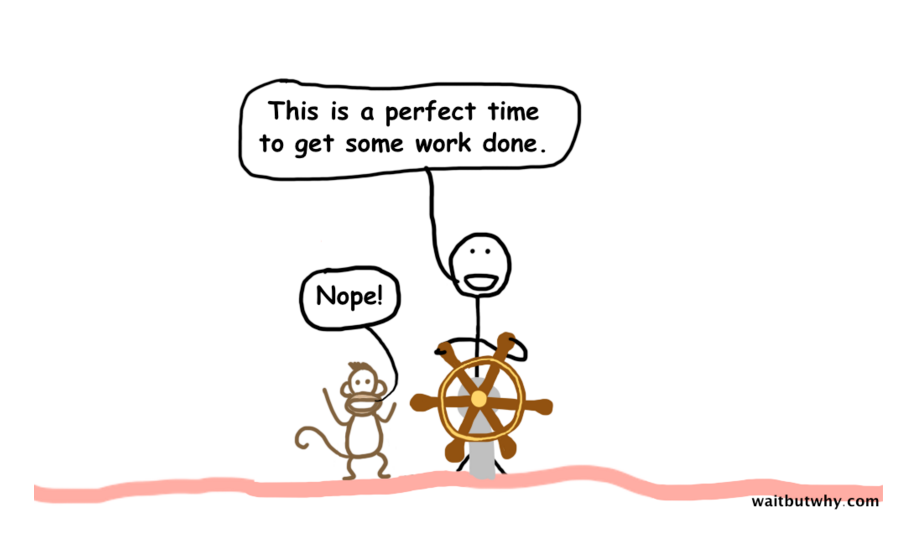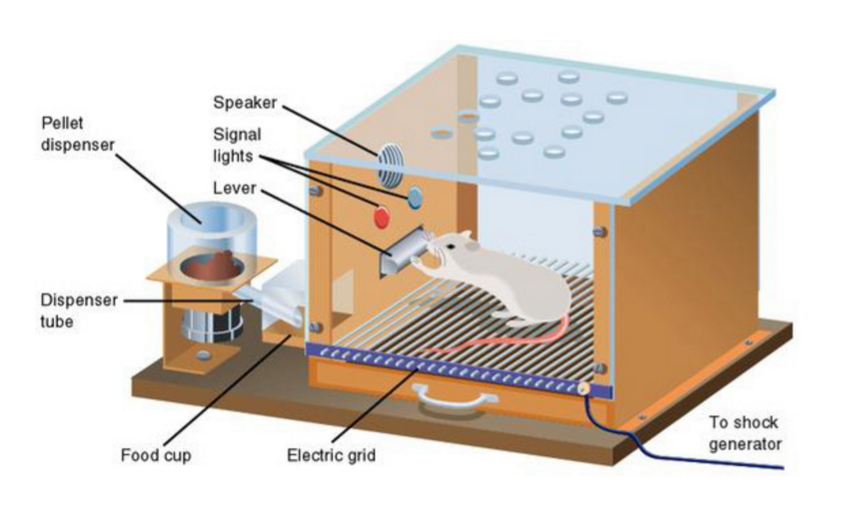Guest Post by Daniel Tay, Piktochart
Daniel is a Content Strategist at Piktochart, where he writes regularly about creativity, design, and storytelling. His motto in life: Always be improving, always be loving. Check out his latest articles over at the Piktochart blog.
Back in the 1800s, American author Herman Melville was facing a problem while writing his to-be masterpiece, Moby Dick. Like many famous creative people who would come after him, he struggled against mankind’s greatest nemesis – procrastination – and even had to resort to chaining himself to his desk to be productive.
That particular story turned out pretty well. Moby Dick went on to become one of the greatest literary works of all time. Sitting at our desks mindlessly scrolling through Facebook, though, it’s hard to imagine that we could ever overcome the Instant Gratification Monkey, and get to work on the ever-increasing mounds of assignments and projects ahead of us.
Even if we did chain ourselves to our desks and get started, distractions continually attempt to try and lure us away. And unlike Melville, we live in an age of perpetual distractions which are easily accessible at the swipe of a finger. Stanford sociologist Clifford Nass says that we are “suckers for irrelevancy.”

Each time we get distracted, we mess up our flow – defined as an “optimal state of consciousness where we feel our best and perform our best.” Not being in the flow is naturally very, very bad for doing actual productive work.
Are we, chronic procrastinators (my hand is raised), doomed to suffer a lifetime of unproductivity? As I’ve found out through lots of distracted reading and experimentation, there’s hope yet.
To learn how to wrestle back control from the monkey, we first have to understand why we procrastinate. Melville’s monkey was in another room–he had to physically get up and move if he wanted to be distracted, so chaining himself to his desk worked. If we want to wrestle back control from the monkey, we’ll have to do a lot more–starting with understanding why we procrastinate.
Operant Conditioning
The idea to put work off first enters our minds when we are faced with tasks that we know to be unpleasant by experience. This happens due to operant conditioning, a term coined by psychologist B.F. Skinner in the 1950s.
As the term suggests, operant conditioning is the process by which we are conditioned to do an action more or less often, depending on whether the action is followed by something good or bad.
Not surprisingly, Skinner found that we are more likely to do an action if whatever follows it is good – and vice versa. Back then, he conducted experiments on animals that he kept in a “Skinner Box,” as shown here:

If the lever was touched, the box would either dispense food or cut off an electric current which was being generated. This way, the rats were physically conditioned to react to positive or negative stimulus.
The same applies to us – not just physically, but mentally too. For example, if I scroll through Facebook and find funny and interesting articles regularly, I would want to keep doing it because my behavior is reinforced by entertainment value.
On the other hand, if writing a blog post makes me feel stressed and overwhelmed, again and again, I would come to fear the process whenever it looms, and actively try to avoid it. Thanks to operant conditioning, this pattern of conditioning is insanely hard to break. Psychologist Brad Stennerson explains it as such:
Every time we avoid something unpleasant, we reinforce our own avoidance behavior. We reward ourselves for procrastinating.
The reward is: I don’t have to do the thing I don’t want to do. For example my reward for not unloading the dishwasher is that I don’t have to unload the dishwasher! Yay! This is a form of negative reinforcement or the removal of a negative consequence.
Using my previous example, the relief of not writing a blog post becomes a reward in itself to me, reinforcing my decision not to write it again next time, and the time after, and again… you get the drill.
That is until the deadline pops up on our horizon. And then panic and stress start setting in.
And panic isn’t a great state of mind to approach work – especially creative projects, which already require a concerted effort to overcome our brain’s laziness. More often than not, it makes it even more unpleasant than it previously would have been, further reinforcing the mindset that writing a blog post = pain, lots of pain. We become conditioned to avoid this negative experience.
Worse still, humans generally have a huge bias towards negativity.
Research shows that negativity is detected far more quickly and easily because the brain region that regulates emotion and motivation uses about two-thirds of its neurons to detect bad news.
The next time I have to write a blog post, don’t be surprised to see me on Facebook more. A lot more. After all, I’ve been conditioned to expect a pleasurable experience from scrolling through Facebook endlessly! And I’m less productive for it.
The Solution: Work Less
How do we break out from this procrastination cycle? The best way to do this is by making a daunting task seem less punishing than it previously was. The focus here is to promote positive reinforcement rather than the negative. This frees your mind of the negativity it once held towards the task and allows it to gradually enjoy and focus on doing good work. Being productive, your brain realizes, is not all that bad.
The first thing you should do is break the task up into smaller parts or steps. Tackling step one out of five, one at a time would definitely seem a lot more manageable than throwing yourself against all five at a go.
Also, chunking tasks give the perception of progress, allowing you to feel accomplished about completing a bunch of little things and hence increasing positive reinforcement.
According to researchers Teresa Amabile and Steven J. Kramer, this is called the progress principle:
“Of all the things that can boost emotions, motivation, and perceptions during a workday, the single most important is making progress in meaningful work.”
Secondly, ensure that you take sufficient breaks in between work sessions. It is pointless to break your project up into component parts, yet power through them all within an hour. It becomes equally punishing and distasteful as before, accomplishing nothing. Instead, the anticipation of taking a rewarding break after tasks contributes to positive reinforcement.
Work Smart with the Pomodoro Technique
The Pomodoro Technique is a good system to keep you within these two boundaries. Invented by entrepreneur Francesco Cirillo in the early 90s, this methodology trains you to break your tasks into smaller parts, and tackle them in short sprints.
Here’s how it works:
- Choose a task to be accomplished.
- Set the Pomodoro to 25 minutes (the Pomodoro is the timer—a lot of them are tomato shaped since Pomodoro is Italian for “tomato.”)
- Work on the task until the Pomodoro rings, then put a check on your sheet of paper
- Take a short break (5 minutes is OK)
- Every 4 Pomodoros take a longer break
- Does 25 minutes seem too long? It’s perfectly okay to start small – even going down to eight minutes per sprint. Productivity guru Merlin Mann explains why:
By making even the most modest bit of progress on your hated task, you’ve done what once seemed impossible: you got started. When you realize how much of the anxiety you’d experienced was created in your head, you’ll experience huge relief and give yourself the jolt needed to get back on track.
Above All: Focus
What is most critical about using this technique is to be one hundred percent focused during each sprint. The time you’ve set aside should be committed to the task, and only the task at hand, otherwise you won’t be productive.
Professor Gloria Mark found that it takes a whopping 23 minutes for an office worker to return to the original task after being sidetracked. By that time, you would barely have made any progress in your task at all, causing you to be discouraged and fall back into the negativity trap.
This might seem hard at first. After all, we’re used to being in the mental “Skinner Box,” and anyone who has tried will tell you that it’s hard to shake off the negative experience. Here’s the good news – there is a tipping point where you will start getting into the flow. Once you get 2/3 or 3/4 of the way through a task, especially if it’s going well, you start to feel great about things and suddenly, the end is in sight.
Slow and Steady
Don’t be worried about accomplishing as much as possible within the allocated time frame. This will cause you to feel anxious, undoing your progress so far. Go slow and steady, and celebrate small successes. The objective of the blocks isn’t quantity – it’s to prove to yourself that the tasks that are ahead of you are not as bad as you thought they were. You’ll be more productive in the long run. As you gain confidence, you’ll naturally get better and better at your work.
Images from WaitButWhy, Flickr, Unsplash
P.S. If you liked this article, you should subscribe to our newsletter. We’ll email you a daily blog post with actionable and unconventional advice on how to work better.

